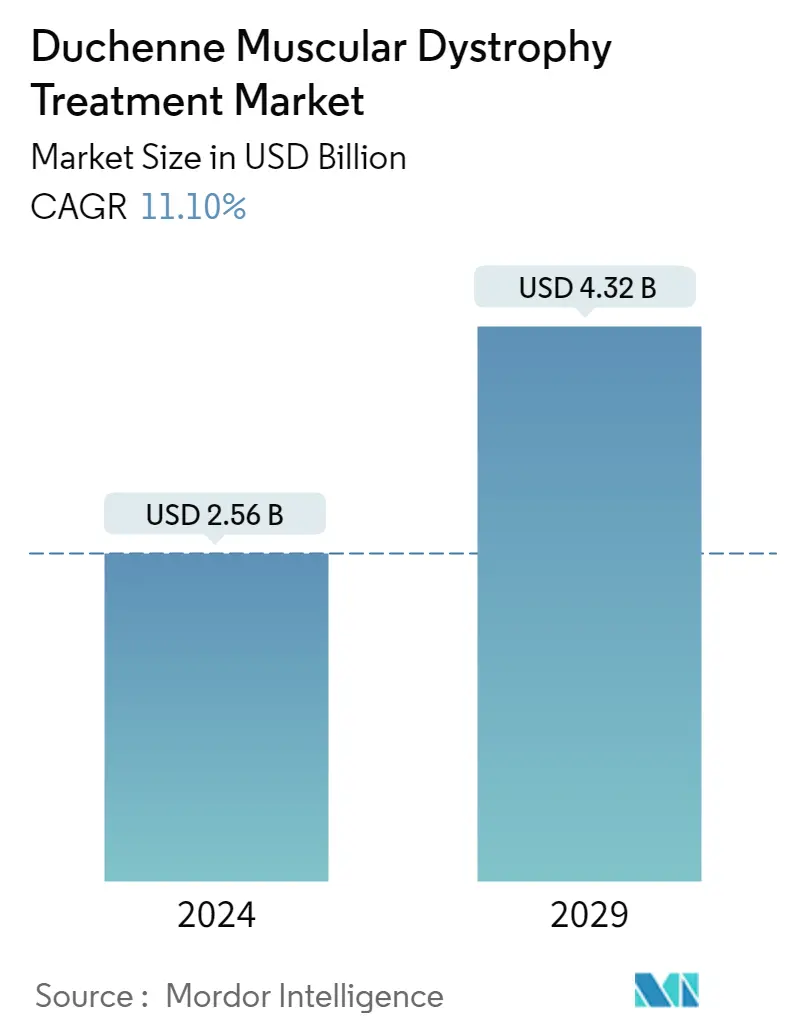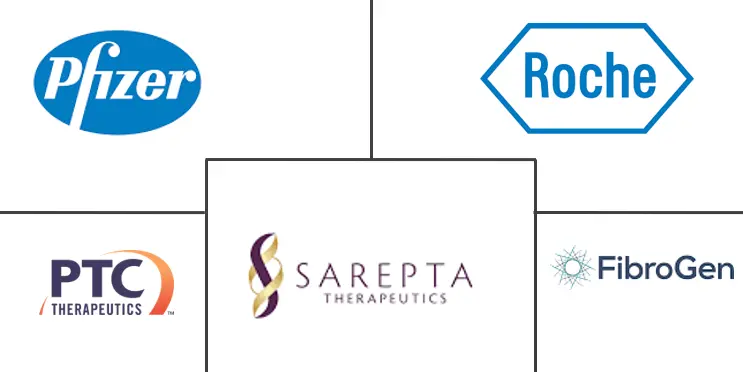Market Size of Duchenne Muscular Dystrophy Treatment Industry

| Study Period | 2019 - 2029 |
| Market Size (2024) | USD 2.56 Billion |
| Market Size (2029) | USD 4.32 Billion |
| CAGR (2024 - 2029) | 11.10 % |
| Fastest Growing Market | Asia-Pacific |
| Largest Market | North America |
Major Players
*Disclaimer: Major Players sorted in no particular order |
Need a report that reflects how COVID-19 has impacted this market and its growth?
Duchenne Muscular Dystrophy Treatment Market Analysis
The Duchenne Muscular Dystrophy Treatment Market size is estimated at USD 2.56 billion in 2024, and is expected to reach USD 4.32 billion by 2029, growing at a CAGR of 11.10% during the forecast period (2024-2029).
The outbreak of COVID-19 impacted the market. The pandemic increased the incidence rate of Duchenne muscular dystrophy. For instance, according to the NCBI research article published in April 2021, people with neuromuscular abnormalities, such as muscular dystrophy, were more likely to experience more severe symptoms of COVID-19, especially if they had cardiac or breathing problems. Similarly, another research article published in April 2021 showed that patients with Duchenne muscular dystrophy were considered a high-risk population due to the worldwide COVID-19 pandemic. The median Forced Vital Capacity increased somewhat, from 76.0% before COVID-19 infection to 79.5% subsequently, among Duchenne muscular dystrophy (DMD) individuals who tested positive for the virus before and after COVID-19, but the difference was not statistically significant. Thus, people suffering from Duchenne muscular dystrophy were more prone to COVID-19, owing to which the treatment adoption rate of Duchenne muscular dystrophy increased to avoid COVID-19 complications during the pandemic. Thus, the market witnessed considerable growth during the pandemic and is expected to maintain an upward trend over the forecast period.
The rising burden of Duchenne Muscular Dystrophy (DMD), increasing investments in research and development of novel therapies for DMD, and increasing awareness campaigns for DMD are the major drivers for the market. For instance, according to the research article published by the NCBI in February 2022, the global prevalence of muscular dystrophy was estimated at 3.6 per 100,000 people, and the largest prevalence in Americans was at 5.1 per 100,000 people. Similarly, as per the data published by the CDC in November 2022, the estimated prevalence of Duchenne and Becker muscular dystrophy (DBMD) was about 1 in every 5,000 males aged 5-9 years. Furthermore, increasing investment in research and development by the private and public sectors has also increased the clinical trials to evaluate potential treatments for Duchenne muscular dystrophy. The sole approved pharmacological therapy for managing DMD is an anti-inflammatory regimen based on corticosteroids. In recent years, there has been a significant increase in the discovery and development of pharmaceutical drugs. Nearly all major companies are now focusing on R&D, which is likely to significantly impact the market in the coming years. For instance, in January 2023, Parent Project Muscular Dystrophy (PPMD) announced a USD 500,000 programmatic investment in Myosana Therapeutics, Inc. (Myosana) to support the company's continuing development and translation of a non-viral gene therapy delivery platform aiming to slow skeletal muscle degeneration and heart failure in Duchenne. Thus, increasing cases of Duchenne Muscular Dystrophy and rising investments in research and development are expected to propel the demand for the treatment, which in turn may positively impact the market growth.
Furthermore, mutation-specific therapies will probably become a breakthrough in treating Duchenne muscular dystrophy. Additionally, there has been an increase in the number of campaigns to raise awareness of Duchenne muscular dystrophy disorder, the development of mutation-specific therapies, the prevalence of the disease, the number of products in development, and the introduction of therapies like Exondys51 and Translarna as well as corticosteroid-based anti-inflammatory drugs. Thus, the introduction of novel medications and therapies, disease-modifying therapies, significant support from several firms for drug research, and support from patient advocacy groups on the regulatory approval process are major drivers of the global market for Duchenne muscular dystrophy.
However, the lack of standardization to measure clinical efficacy across all stages of DMD may hinder the market growth over the forecast period.
